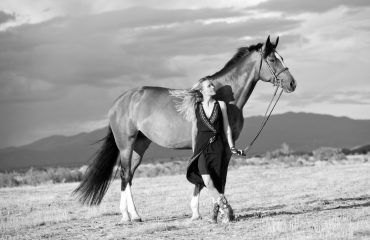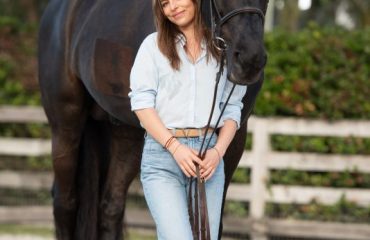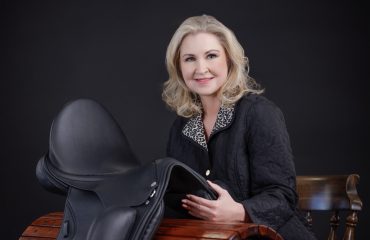By Lori Ovanessian with Britney Grover
Portraits by Lori Ovanessian
In the Southern California horse show world, 20-year-old Dylan Ryan is redefining what it means to be an amateur rider.
To those who know her, it’s not surprising: She’s spent her entire riding career breaking molds.
As a senior, Dylan has had to fit riding around school — not the other way around. She’s worked with problem horses and made the best out of what was available to her. She’s also had to buy helmets two sizes too big just to fit her voluminous curls, and weathered demeaning questions about her unique mixed-race appearance.
Just because she doesn’t have plans to go pro doesn’t mean Dylan isn’t serious about riding and competing. Now a college senior, Dylan and her Thoroughbred, Bart, are turning heads in the 1.20m jumpers. You’d never know that Dylan couldn’t stop or steer Bart when she first started riding him.
School First
Dylan was raised in Bakersfield, California, and her passion for horses began with pony rides in Griffith Park every Sunday as a 3-year-old. After years of dance and gymnastics, her parents finally allowed her to start riding lessons. They had no idea what they were getting into.
“My mom rode a bit when she was younger, but nothing serious,” Dylan said. “My dad’s side of the family is extremely athletic, with most of the siblings competing at the highest levels of their various sports. For me, this was the sport that clicked and I was lucky enough to have parents who supported me in that, even though they knew nothing about it.” 
By the time she was 8, Dylan was competing. Though her parents fully supported her riding, it was always clear school was the first priority.
“We had an agreement in my house that in order for me to continue riding, I had to get A’s in all of my classes,” Dylan said. “Thankfully, I was highly motivated to keep my barn time, so as long as I never fell behind on schoolwork, I could ride as much I wanted.”
Homeschool was never an option, so shows had to fit around Dylan’s school schedule — not the other way around. And if her homework for that week wasn’t finished by the time she got home from the show, she wasn’t allowed to attend the next one.
At times, it was frustrating to watch other girls progress faster in the show world because they could show more often or had access to more finished horses, but Dylan made the best of both worlds: excelling in school and developing her skill in the saddle.
Equestrian Education
Rather than riding polished, fancy show horses, Dylan learned how to handle the dirty stoppers and the green horses. Her barn specialized in “problem” horses and those that the owners didn’t have time to put training on — everything from young horses to horses with unfortunate backgrounds and accompanying bad habits.
“Riding the more difficult horses really teaches you how to problem-solve,” Dylan said. “You have to learn to think for yourself, which is such a crucial skill in the show ring.”
Dylan also absorbed all she could from the wide variety of trainers throughout her riding years, beginning with Gabe Belluomini and his old-fashioned approach to the show jumping world with a bit of a Western background. Other trainers have included Olympic alternate Mimi Combs and her husband Mark, both 5* event riders, as well as Scott Neill, a foxhunter from New Zealand.
“I think it’s very helpful to experience a variety of perspectives because there isn’t one correct way to do anything,” Dylan said. “All of the trainers I’ve ridden with have basically the same end goal but vastly different approaches to achieving it, and I think it’s important to have all those tools available to you.”
 Between fitting showing around school and competing on horses that spooked or didn’t quite have lead changes down, Dylan’s junior career didn’t advance as quickly as others. That didn’t stop her from enjoying every minute in the saddle, but she also saw a side of the sport that some don’t see — and others know all too well.
Between fitting showing around school and competing on horses that spooked or didn’t quite have lead changes down, Dylan’s junior career didn’t advance as quickly as others. That didn’t stop her from enjoying every minute in the saddle, but she also saw a side of the sport that some don’t see — and others know all too well.
“I’ve been very fortunate to have the opportunities I’ve had,” she said. “But there’s an element of inequality in our sport that some are acutely aware of, and that others are completely unaware of.”
Dylan’s mother comes from Afro-Caribbean roots with some Scottish and Native American ancestry. Her dad’s side of the family is Irish/English. As a result, Dylan has a unique look — which she enjoys.
“I’m in a unique position because my skin really isn’t that dark, so people don’t automatically assume I’m Black, but they also recognize that I’m not just white either,” she said. “I get a lot of questions like, ‘What are you?’ which people don’t often realize can sound so demeaning.”
Though she says she’s been lucky not to have been the target of strong racial prejudice that darker-skinned people have, she’s also been aware of the inequality present within equestrian sport, from wealth to preferred body and even hair type.
“I’m very fortunate to come from a family who is able to support my passion and provide the financial backing to let me compete in a few shows each year,” Dylan said, “but I think more people in the equestrian community need to be aware of how the exorbitant cost of this sport plays a role in prolonging social and racial inequality.”
At shows, Dylan has always been aware of the lack of diversity and notices that she maybe saw only one other black or Latino person in show clothes that day. “It would have been nice to see another mixed, curly-haired rider as inspiration as I was growing up, to know that someone who looks like me is capable of achieving great things,” she said.
Now, Dylan might just be that inspiration to other young riders.
Rapid Transit
At the end of her junior career in 2016, Dylan was competing in hunters, jumpers and equitation all on one horse, at one show. “Eventually, it was just too much for his brain to handle,” Dylan said. “Gabe jokingly said to me one day, ‘I’m going to get you a 1.20m horse,’ and I just laughed it off. But I came to the barn the next week and Gabe pointed to the horse in turnout. He said, ‘I told you I would.’”
The 15.3-hand Thoroughbred didn’t look like anything special at the time, and Dylan wasn’t immediately a fan of his name: Bart. Her dad pointed out that BART is also the acronym for the Bay Area Rapid Transit, and not only did it ease Dylan’s opinion of the name but Rapid Transit became Bart’s show name. Other issues, however, were not so easily remedied.
“I couldn’t stop or steer him for about the first month,” Dylan recalled. “I’d ridden a fair number of horses by that point, and he was nothing like I’d ever been on. He always just wanted to go faster, and even when we were completely out of control he would still rather jump the fence than go around it.”
It took eight months of hard work before things began clicking for Dylan and Bart, and she began to see the potential of their partnership. “Of course, I was still getting dragged around the arena pretty often, so we had a way to go,” Dylan said. “But suddenly we were working together instead of against each other.”
After their first 1.20m class together, Dylan says she was in total shock. Early in her riding career, she had accepted the idea that she wouldn’t be able to compete at bigger heights because she couldn’t afford a made horse. Competing at 1.20m was something she had talked about, but never really expected to be able to do with her resources.
“And then here comes Bart, this wild little backyard horse that completely changed my world,” Dylan said. “We both had the heart and ability to do it; it was just a matter of getting it done safely and actually entering the class.” 
Jumping Big
It’s that heart that draws attention at the shows. Grooms, trainers and spectators all comment on how quick Bart is around a course or how much fun he looks to ride.
“He has this sort of electricity around him when we enter the ring, and other people notice it, too,” Dylan said. “When both the horse and rider truly love what they’re doing, people can tell.”
Now training with Amy Hess, who has a racetrack background in addition to her hunter-jumper and grand prix experience, Dylan is passionate about showcasing Bart’s talents as a Thoroughbred. She participates in Thoroughbred classic horse shows, and is quick to praise the value of the breed.
“There’s something really special about how much effort a Thoroughbred is willing to give you,” she said. “If you’re willing to take the challenge and put the work in, the rewards are endless.”
Dylan’s high school days balancing a full AP course schedule, community volunteer work and riding five days a week prepared her well for her current lifestyle balancing her riding with her school schedule at Occidental College. She’s studying cognitive science and linguistics, and hopes to work doing cognitive rehabilitation with people who have had brain injuries — and hasn’t ruled out equine therapy as an avenue for her practice.
But whether or not horses are in her life as part of her career, they will stay in her life. “Amateurs get a bad rap sometimes,” Dylan said. “Typically it’s all about the junior medal finals or the professionals in the grand prix.
“But then I came across a quote that reminded me what everyone is doing here: ‘You say ‘amateur’ as if it was a dirty word. ‘Amateur’ comes from the Latin word ‘amare’ which means to love … to do things for the love of it.’ And while some of us are here because it’s a job or something you’ve always wanted to do, all of us who are in it for the long run are here for the same reason: pure love for a horse.”
Photos by Lori Ovanessian, simpleefocused.com
Photo shoot location: Amy Maldonado’s farm in Bakersfield, California













